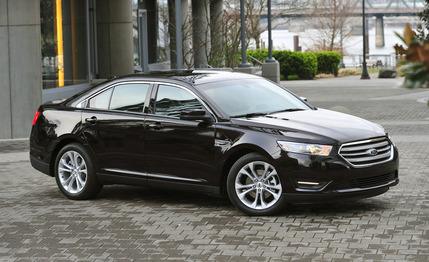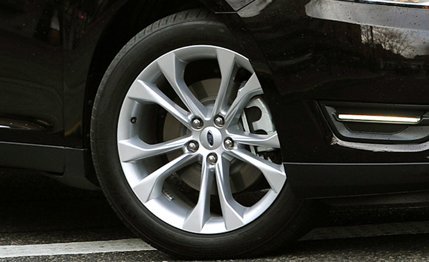
 Instrumented Test
Instrumented Test


Freshened for 2013, the Taurus is reminiscent of Ford’s top-of-the-line family sedans of yesteryear, cars such as the Galaxie 500, the LTD: big, comfortable, and quiet, with relaxed dynamics and respectable power. Plus interior appointments that border on luxury. But even though Taurus pricing can soar well above the $40,000 threshold, Ford refrains from portraying it as a luxury sedan. As with its premium family-sedan forebears, luxury is the province of Lincoln.
Nevertheless, there’s lots of luxury here. Check the amenities in our $35,240 all-wheel-drive SEL test car: leather seats with power adjustability and heat up front, dual-zone auto climate control, auto-up-and-down power windows, remote starting, AM/FM/CD audio with an auxiliary jack and satellite radio, power-adjustable pedals, ambient lighting, a rearview camera, updated MyFord Touch secondary controls with voice-activated Sync connectivity, a tilting-and-telescoping steering column, adaptive cruise control, and blind-spot warning with cross-traffic alert. (In addition, Taurus models offer a new self-parking feature, although this wasn’t a part of our test car’s equipment.)
Some of the foregoing is optional equipment. But it all adds up to a car that coddles its occupants with a rich and serene driving environment that makes ordinary commuting and cross-country driving very pleasant indeed.
But let’s not confuse pleasant with stimulating.
Creamy Attitude
Ford characterizes the updated Taurus as “aesthetically refined,” which is plausible, and “athletically refined,” which isn’t, unless you’re talking about the SHO. The mainstream members of the family, including this SEL, are tuned for creamy ride quality, which they certainly deliver. They do so at the expense of considerable body roll, as well as a fair amount of up-and-down motion on bumpy roads. All of this isolates occupants from the unpleasant realities of nasty pavement but makes cornering a matter of patience, transient responses deliberate, and understeer the defining dynamic trait.


New electric-assisted power steering adds to the car’s conservative dynamics. It’s quick, at 2.8 turns lock-to-lock, but numb and lifeless. Braking performance, too, is no better than so-so. Equipped with optional 19-inch wheels and low-profile Michelin Primacy MXM4 all-season tires (255/45), our test vehicle put up a respectable skidpad number—0.84 g—but its stopping distance of 182 feet from 70 to 0 mph is lamentable in a family sedan.
Power Choices
Unlike some of its premium-sedan competition—the Hyundai Azera, the Nissan Maxima, the Toyota Avalon—the Taurus offers several engines: an optional 2.0-liter EcoBoost four, which is new to this car for 2013; a 3.5-liter EcoBoost V-6, exclusive to the high-performance SHO; and a naturally aspirated 3.5-liter V-6, the standard Taurus powerplant, upgraded for 2013 with variable timing on all four overhead cams. Output for the naturally aspirated 3.5-liter six tested here rises to 288 hp and 254 lb-ft, gains of 25 hp and 5 lb-ft of torque. The standard V-6 also scores a 2-mpg increase in its EPA highway fuel-economy rating, which climbs to 26 mpg (the city number remains at 18). We logged 21 mpg in our testing.
Every Taurus is equipped with a six-speed automatic transmission that offers a manual operating mode. All-wheel drive is a $1850 option for SEL and Limited trim levels with the base 3.5-liter, and our test car was so equipped.